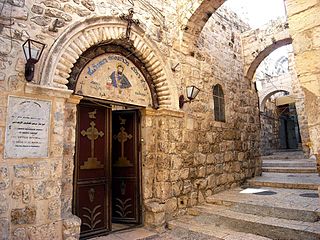
Seeing Islam As Others Saw It: A Survey and Evaluation of Christian, Jewish and Zoroastrian Writings on Early Islam from the Studies in Late Antiquity and Early Islam series is a book by scholar of the Middle East Robert G. Hoyland.
The Maronite Chronicle is an anonymous annalistic chronicle in the Syriac language completed shortly after 664. It is so named because its author appears to have been a Maronite. It survives today only in a single damaged 8th- or 9th-century manuscript in London, British Library Add. 17,216. Owing to the damage, portions of the chronicle are lost.
Athanasius II Baldoyo, also known as Athanasius of Balad, and Athanasius of Nisibis, was the Patriarch of Antioch and head of the Syriac Orthodox Church from 684 until his death in 687.
Quriaqos of Tagrit was the Patriarch of Antioch, and head of the Syriac Orthodox Church, from 793 until his death in 817. He is commemorated as a saint by the Syriac Orthodox Church in the Martyrology of Rabban Sliba, and his feast day is 13 or 16 August.
Zuqnīn Monastery was a Syriac Orthodox monastery near Diyarbakır in Turkey. It produced one patriarch and fourteen bishops.
Elias I of Antioch was the Patriarch of Antioch and head of the Syriac Orthodox Church from 709 until his death in 723. He is commemorated as a saint by the Syriac Orthodox Church in the Martyrology of Rabban Sliba, and his feast day is 3 November.
Athanasius I Gammolo was the Patriarch of Antioch and head of the Syriac Orthodox Church from 594/595 or 603 until his death in 631. He is commemorated as a saint by the Syriac Orthodox Church in the Martyrology of Rabban Sliba, and his feast day is 3 January.
Julian I was the Patriarch of Antioch and head of the Syriac Orthodox Church from 591 until his death in 594/595. He is commemorated as a saint by the Syriac Orthodox Church.
Severus II bar Masqeh was the Patriarch of Antioch and head of the Syriac Orthodox Church from 667/668 until his death in 684. He is commemorated as a saint by the Syriac Orthodox Church.
Theodosius Romanus was the Patriarch of Antioch and head of the Syriac Orthodox Church from 887 until his death in 896.
Dionysius II was the Patriarch of Antioch and head of the Syriac Orthodox Church from 896/897 until his death in 908/909.

The Monastery of Saint Mark the Evangelist and the Virgin Mary is a Syriac Orthodox monastery in the Armenian Quarter of the Old City of Jerusalem and residence of the Syriac Orthodox Archbishop of Jerusalem. It is believed to be located on the site of house of Mary, mother of Mark the Evangelist, and claims to be the first church in Christianity. The monastery consists of the main church of Saint Mark and an adjacent chapel of Saint Behnam.
Mar Paul, usually known as Paul of Edessa or Paul of Cyprus, was the Byzantine Syriac Orthodox metropolitan of Edessa who was forced to abandon his see between about 602 and 629, when it fell under the Sasanian Empire. He was an important translator of Greek theological works into Syriac. He should not be confused with the Bishop Paul of Edessa who died in 526.
Qenneshre was a large West Syriac monastery between the 6th and 13th centuries. It was a centre for the study of ancient Greek literature and the Greek Fathers, and through its Syriac translations it transmitted Greek works to the Islamic world. It was "the most important intellectual centre of the Syriac Orthodox ... from the 6th to the early 9th century", when it was sacked and went into decline.
John bar Aphtonia (c.480–537) was a Syriac monk of the Miaphysite persuasion who founded around 530 the monastery of Saint Thomas in Qenneshre, located on the eastern side of the Euphrates in present northern Syria. A key figure in the transmission of Greek thought and literary culture into a Syriac milieu, his monastery became the intellectual centre of the West Syriac world for the next three centuries.
Theodore was the Syriac Orthodox patriarch of Antioch whose term began between 649 and 651 and ended with his death between 664 and 667.
George was the Syriac Orthodox bishop of the Arabs around Aleppo and the upper Euphrates from 686 or 687 until his death. A polymath steeped in ancient Greek philosophy, his writings are an important source for Syriac history and theology.
John the Stylite, also known as John of Litharb, was a Syriac Orthodox monk and author. He was a stylite attached to the monastery of Atarib and part of a circle of Syriac intellectuals active in northern Syria under the Umayyad dynasty.
Ishoʿdnaḥ was a historian and hagiographer of the Church of the East who served as the metropolitan bishop of Mayshan at Baṣra. Some manuscripts refer to him as metropolitan of the diocese of Qasra, but this appears to be a simple spelling error, since Qasra was never a metropolitan see.

Claudias or Qlaudia was a fortress in the Taurus Mountains and, by extension, its district. Its precise location is now unknown.